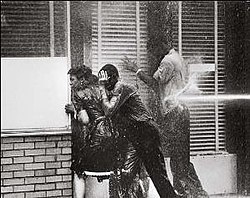 |
| http://foundsf.org/index.php?title=The_Hunters_Point_Riot (Sept. 27, 1966) |
We got off to an auspicious start with the Aptitude Test (smile) and a lively discussion on the meaning of Critical Thinking and what constitutes language and whether or not one can think if one has no way to communicate these thoughts.
There are too many students and not enough seats. The Wait List is too short and the number or compelling stories as to why I should admit this student over that student is too much to contemplate presently, suffice it to say, for those who prudently got into the class before the cut-off, count your blessings and don't miss any classes these first two weeks (smile). I cannot drop anyone, but. . . .
We walked over to A-205 to watch a film Take This Hammer (PBS), which chronicles James Baldwin's tour of San Francisco's Bayview Hunter's Point 40 years ago. What makes this film compelling and why I wanted you to see it, was to give you a feel for Baldwin, whose letter to his nephew is one of two essays we will read his classic, The Fire Next Time. I think Baldwin is one of America's prized scholars and the master of the essay. The breath of his knowledge and his ability to link his scholarship to the personal issues he was most compassionate about like justice and peace is brilliant.
I had the opportunity to interview a few of the men who were children, teens at the time of Baldwin's visit on my radio show last year as well as a filmmaker who made a new film looking at Bayview 2012. Both the films were shown in a program at The Luggage Store Gallery in San Francisco.
 |
| Birmingham, AL, 1963 (Google Images) |
 |
| 4 Little Girls killed in a church bombing in Birmingham, AL |
The claim "there will never be a black president in America" is an argument. It is a debatable claim. When we add the word "because" behind the claim we often find evidence supporting the conclusion, that is, so and so is true because. . . or this is true and that is true therefore this has to be true or valid.
In argument we often do not have certainty, just validity. Sometimes the evidence just points to a probability.
Within your 2 page response give the context and feel free to use your own experiences to reflect on this brief and edited version of Baldwin's visit to Hunter's Point in San Francisco. Use the film for citations which can take the form of free paraphrases and direct quotes.
Baldwin is not easy. One needs to know one's American history. In the opening narrative the filmmaker gives us an overview of the film. If you do not know what was happening in America in 1963 refresh your memory of what was going on re: The Civil Rights Movement. What happened in Birmingham? See http://www.english.illinois.edu/maps/poets/m_r/randall/birmingham.htm
http://foundsf.org/index.php?title=The_Hunters_Point_Riot (Sept. 27, 1966)
http://vimeo.com/13175192
"KQED's mobile film unit follows author and activist James Baldwin in the spring of 1963, as he's driven around San Francisco to meet with members of the local African-American community. He is escorted by Youth For Service's Executive Director Orville Luster and intent on discovering: "The real situation of Negroes in the city, as opposed to the image San Francisco would like to present." He declares: "There is no moral distance ... between the facts of life in San Francisco and the facts of life in Birmingham. Someone's got to tell it like it is. And that's where it's at." Includes frank exchanges with local people on the street, meetings with community leaders and extended point-of-view sequences shot from a moving vehicle, featuring the Bayview and Western Addition neighborhoods. Baldwin reflects on the racial inequality that African-Americans are forced to confront and at one point tries to lift the morale of a young man by expressing his conviction that: "There will be a Negro president of this country but it will not be the country that we are sitting in now." The TV Archive would like to thank Darryl Cox for championing the merits of this film and for his determination that it be preserved and remastered for posterity."
We also discussed textbooks, a few students purchased books. We will start reading The Fire Next Time first and then Tim Wise's book, Dear White America: A Letter to a New Minority. These should be fast reads. As we read these books we will run through the text book, Writing Logically, Thinking Critically. Students will work in groups on the exercises which will be homework.
You have the option of keeping a notebook g for the exercises and writing in the book. Essays are to be typed along with cyber-assignments. Students will turn in essays electronically where indicated. More in the syllabus.
Here is a link to the exhibit at The Luggage Story Gallery:
http://www.examiner.com/article/james-baldwin-rare-film-and-new-documentary
Here are links to the two shows where I interviewed the director the men then boys in the first documentary:
http://www.blogtalkradio.com/wandas-picks/2012/06/19/take-this-hammer-james-baldwin-in-san-francisco
http://www.blogtalkradio.com/wandas-picks/2012/06/15/wandas-picks-radio-show
Here are all the images from Google:
https://www.google.com/search?q=birmingham+1963&hl=en&tbo=u&tbm=isch&source=univ&sa=X&ei=tQcDUcjYLejKigK-44DYBQ&sqi=2&ved=0CDsQsAQ&biw=986&bih=611
This comment has been removed by the author.
ReplyDelete